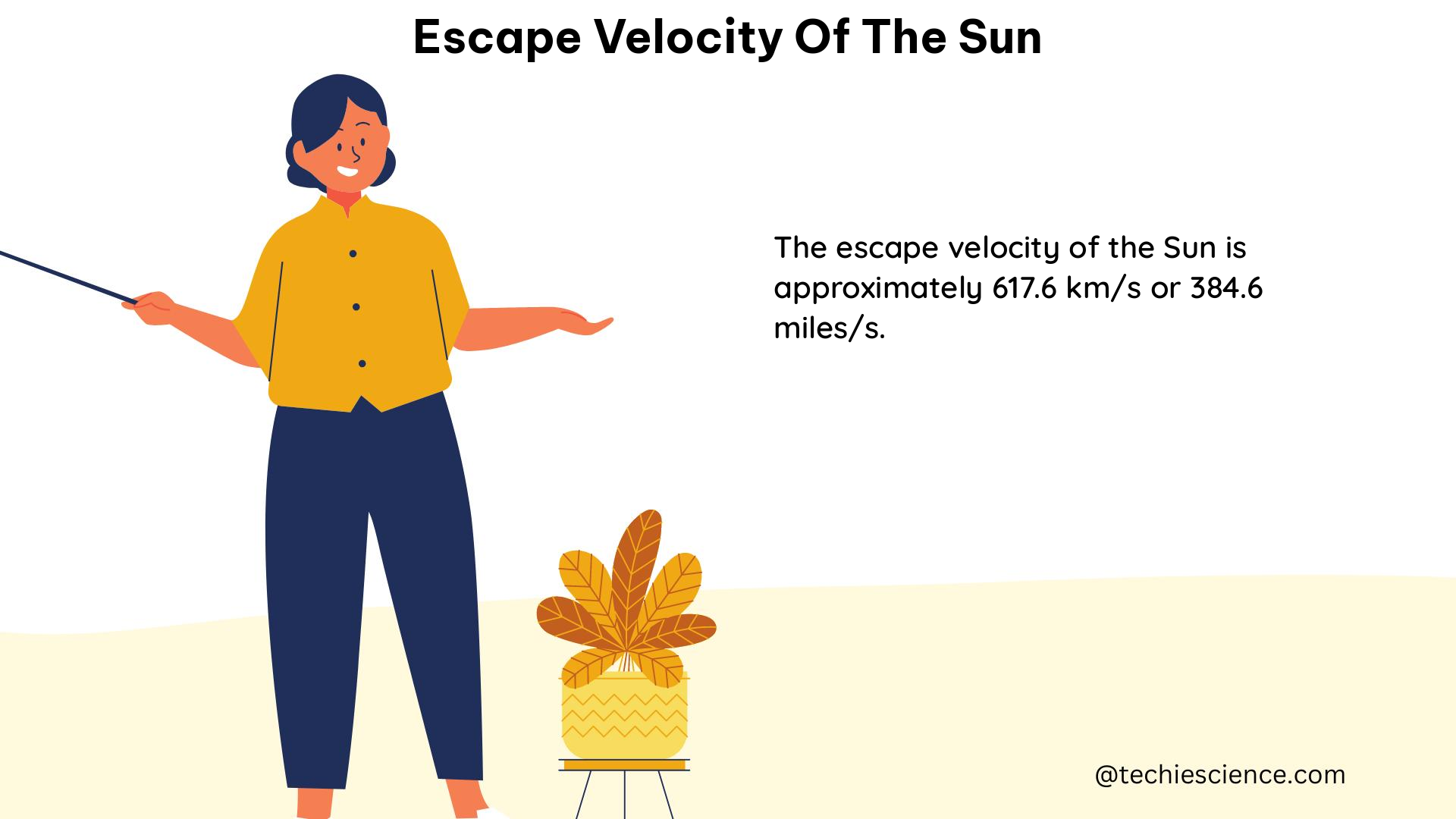The escape velocity of the Sun is a critical concept in astrophysics and space exploration, representing the minimum speed required for an object to escape the Sun’s gravitational pull. This value is calculated using a specific formula and has important implications for spacecraft design, interplanetary travel, and our understanding of the solar system.
Understanding the Escape Velocity Formula
The escape velocity of the Sun is calculated using the following formula:
( v_{esc} = \sqrt{\frac{2 \cdot G \cdot M_{sun}}{r}} )
Where:
– v_{esc} is the escape velocity of the Sun
– G is the gravitational constant, with a value of approximately 6.674 × 10^-11 m^3/kg·s^2
– M_{sun} is the mass of the Sun, which is approximately 1.989 × 10^30 kg
– r is the radial distance from the center of the Sun
Calculating the Escape Velocity at the Earth’s Distance

To calculate the escape velocity at the Earth’s distance from the Sun, we can substitute the relevant values into the formula:
( r = 1 \text{ AU} \approx 1.496 \times 10^8 \text{ km} )
( v_{esc} = \sqrt{\frac{2 \cdot 6.674 \times 10^{-11} \frac{m^3}{kg \cdot s^2} \cdot 1.989 \times 10^{30} \text{ kg}}{1.496 \times 10^{11} \text{ m}}} )
( v_{esc} \approx 617.7 \text{ km/s} )
This means that an object at the Earth’s distance from the Sun (1 AU) would need to reach a minimum speed of approximately 617.7 km/s to escape the Sun’s gravitational influence.
Comparison to Orbital Velocity
It’s important to note that the escape velocity is always greater than the orbital velocity of a planet or object around the Sun. This is because the escape velocity is derived from the conservation of mechanical energy, requiring an object to reach a specific kinetic energy to balance out its gravitational potential energy at an infinite distance, effectively reducing its total mechanical energy to zero.
For example, the orbital velocity of the Earth around the Sun is approximately 29.8 km/s, which is significantly lower than the escape velocity of 617.7 km/s at the Earth’s distance.
Implications for Space Exploration
The escape velocity of the Sun has important implications for space exploration and spacecraft design. Achieving the necessary escape velocity is a critical requirement for any spacecraft or object that aims to leave the solar system and enter interstellar space.
Spacecraft Design Considerations
Spacecraft designers must ensure that their vehicles have sufficient propulsion power and fuel to reach the escape velocity of the Sun. This often requires the use of powerful rocket engines and efficient fuel management systems.
Interplanetary Travel
The escape velocity also plays a role in the design and planning of interplanetary missions. While it may be easier to escape the solar system than to reach the innermost planets like Mercury, spacecraft still need to overcome the Sun’s gravitational pull to travel to other destinations within the solar system.
Gravitational Slingshot Maneuvers
One technique used to overcome the high escape velocity of the Sun is the gravitational slingshot maneuver. This involves using the gravity of a planet or other celestial body to gain additional momentum and increase the spacecraft’s velocity, effectively reducing the amount of fuel required to escape the solar system.
Numerical Examples and Data Points
To further illustrate the concept of the Sun’s escape velocity, let’s consider some additional numerical examples and data points:
- Escape Velocity at the Surface of the Sun:
- At the surface of the Sun, the escape velocity is approximately 617.5 km/s.
-
This is significantly higher than the escape velocity at the Earth’s distance, due to the Sun’s much stronger gravitational field near its surface.
-
Escape Velocity at Different Distances from the Sun:
| Distance from Sun | Escape Velocity |
| —————– | ————— |
| 1 AU (Earth) | 617.7 km/s |
| 0.39 AU (Mercury) | 859.8 km/s |
| 5 AU (Jupiter) | 428.5 km/s |
| 30 AU (Neptune) | 237.1 km/s | -
Comparison to Other Celestial Bodies:
- The escape velocity of the Earth is approximately 11.2 km/s, much lower than the Sun’s escape velocity.
-
The escape velocity of Jupiter is approximately 59.5 km/s, also significantly lower than the Sun’s.
-
Spacecraft Velocities:
- The Parker Solar Probe, launched in 2018, is the fastest-moving spacecraft ever built, with a top speed of over 690 km/s, which is sufficient to escape the Sun’s gravitational pull.
- The Voyager 1 spacecraft, launched in 1977, has a current speed of approximately 17 km/s, which is not enough to escape the solar system on its own. However, it was able to use a gravitational slingshot maneuver around Jupiter to gain the necessary velocity to leave the solar system.
Conclusion
The escape velocity of the Sun is a fundamental concept in astrophysics and space exploration, representing the minimum speed required for an object to escape the Sun’s gravitational influence. By understanding the formula, calculating the escape velocity at different distances, and considering the implications for spacecraft design and interplanetary travel, we can better navigate the challenges and opportunities of exploring our solar system and beyond.
References
- Why is it easier to escape the solar system than get to Mercury or the Sun?
- Escape velocity of the Sun
- Velocity of Escape from the Sun
- Escape Velocity
- Escape Velocity (Astronomy)

The lambdageeks.com Core SME Team is a group of experienced subject matter experts from diverse scientific and technical fields including Physics, Chemistry, Technology,Electronics & Electrical Engineering, Automotive, Mechanical Engineering. Our team collaborates to create high-quality, well-researched articles on a wide range of science and technology topics for the lambdageeks.com website.
All Our Senior SME are having more than 7 Years of experience in the respective fields . They are either Working Industry Professionals or assocaited With different Universities. Refer Our Authors Page to get to know About our Core SMEs.